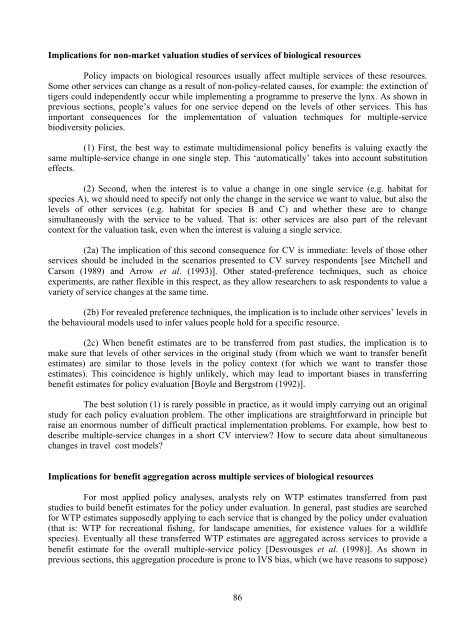Implications for non-market valuation studies <strong>of</strong> services <strong>of</strong> biological resourcesPolicy impacts on biological resources usually affect multiple services <strong>of</strong> these resources.Some other services can change as a result <strong>of</strong> non-policy-related causes, for example: the extinction <strong>of</strong>tigers could independently occur while implementing a programme to preserve the lynx. As shown inprevious sections, people’s values for one service depend on the levels <strong>of</strong> other services. This hasimportant consequences for the implementation <strong>of</strong> valuation techniques for multiple-servicebiodiversity policies.(1) First, the best way to estimate multidimensional policy benefits is valuing exactly thesame multiple-service change in one single step. This ‘automatically’ takes into account substitutioneffects.(2) Second, when the interest is to value a change in one single service (e.g. habitat forspecies A), we should need to specify not only the change in the service we want to value, but also thelevels <strong>of</strong> other services (e.g. habitat for species B and C) and whether these are to changesimultaneously with the service to be valued. That is: other services are also part <strong>of</strong> the relevantcontext for the valuation task, even when the interest is valuing a single service.(2a) The implication <strong>of</strong> this second consequence for CV is immediate: levels <strong>of</strong> those otherservices should be included in the scenarios presented to CV survey respondents [see Mitchell andCarson (1989) and Arrow et al. (1993)]. Other stated-preference techniques, such as choiceexperiments, are rather flexible in this respect, as they allow researchers to ask respondents to value avariety <strong>of</strong> service changes at the same time.(2b) For revealed preference techniques, the implication is to include other services’ levels inthe behavioural models used to infer values people hold for a specific resource.(2c) When benefit estimates are to be transferred from past studies, the implication is tomake sure that levels <strong>of</strong> other services in the original study (from which we want to transfer benefitestimates) are similar to those levels in the policy context (for which we want to transfer thoseestimates). This coincidence is highly unlikely, which may lead to important biases in transferringbenefit estimates for policy evaluation [Boyle and Bergstrom (1992)].The best solution (1) is rarely possible in practice, as it would imply carrying out an originalstudy for each policy evaluation problem. The other implications are straightforward in principle butraise an enormous number <strong>of</strong> difficult practical implementation problems. For example, how best todescribe multiple-service changes in a short CV interview? How to secure data about simultaneouschanges in travel cost models?Implications for benefit aggregation across multiple services <strong>of</strong> biological resourcesFor most applied policy analyses, analysts rely on WTP estimates transferred from paststudies to build benefit estimates for the policy under evaluation. In general, past studies are searchedfor WTP estimates supposedly applying to each service that is changed by the policy under evaluation(that is: WTP for recreational fishing, for landscape amenities, for existence values for a wildlifespecies). Eventually all these transferred WTP estimates are aggregated across services to provide abenefit estimate for the overall multiple-service policy [Desvousges et al. (1998)]. As shown inprevious sections, this aggregation procedure is prone to IVS bias, which (we have reasons to suppose)86
is potentially very large for multidimensional biodiversity policies. So, these usual procedures arelikely to increase the probability <strong>of</strong> recommending the wrong policy decision.What is the practical alternative? In most policymaking contexts, it is impossible tocommission an original study for each policy, because <strong>of</strong> budget and time constraints. However, giventhe potential magnitude <strong>of</strong> the bias (hence, the likelihood and expected cost <strong>of</strong> wrong decisions beingtaken), further research on substitution effects is recommended, to gain an understanding for themagnitude <strong>of</strong> these effects under different circumstances, and with different types <strong>of</strong> biologicalresources. Only then can we expect to derive the appropriate adjustment factors to correct for IVSbiases.Sequential cost-benefit analysis for the selection <strong>of</strong> an optimal policy mix for biodiversityVery <strong>of</strong>ten, policymakers are not concerned with evaluating a proposed policy for abiodiversity issue, but in determining an optimal policy mix from a set <strong>of</strong> possible alternatives. This isparticularly clear when several lines <strong>of</strong> action need to be prioritised for inclusion in a generalbiodiversity strategy, under conditions <strong>of</strong> scarce funds for policy implementation. What is the propertechnique to use for these purposes when substitution effects are expected to be significant, as it is thecase with multidimensional biodiversity policies?Substitution implies that the value <strong>of</strong> a particular policy component depends, in general, onwhich other components are to be included in the policy mix. Under these circumstances, the only wayto determine an optimal policy mix is to evaluate the (successively more inclusive) policy mixes thatwill result from sequentially adding up more components to the mix. This is sequential cost-benefitanalysis and requires sequential values <strong>of</strong> policy components. The basic approach was proposed inSantos (1996). It is analysed in detail and applied to policy evaluation in Santos (1998).Briefly, the method proceeds as follows. First, identify the most complete biodiversitypolicy mix that is possible (that is: unconstrained by social cost or financial budget). Second, dividethis mix into a number <strong>of</strong> ‘programmes’. Each programme comprises a particular subset <strong>of</strong> valuedbiodiversity components or functions. Components included in different programmes should beindependent in production, so that policymakers may choose to implement any possible mix <strong>of</strong> theprogrammes once this is selected as the best. The problem for policy makers is how to select the singlebest possible mix. There are two policy settings defining what ‘best’ means: in the first, ‘best’ meanswelfare maximising, and identifying it implies using a social cost-benefit frame; in the second, policyfunds are budget constrained, and thus ‘best’ means the one making the best use <strong>of</strong> available funds.For the solution for the social cost-benefit problem, we should sequentially evaluate thewelfare effects <strong>of</strong> adding particular programmes to a previously constituted mix. If the evaluation isconsidered positive (that: is if the social benefit/cost ratio is larger than one), then the programme isadded to the previous mix. Another candidate programme is considered next, and so on until there areno more remaining programmes with social benefits <strong>of</strong>fsetting the corresponding social costs.If we consider the financial budget constrained approach, a simpler non-sequential approachis possible. This implies estimating the benefit <strong>of</strong> every single programme-mix and selecting the mixgenerating the highest benefit while not exceeding the available financial budget.To illustrate the sequential procedure, consider the Pennine Dales ESA example we havefollowed throughout the paper. First, note that we need sequential benefits <strong>of</strong> each programme. Theseare easily calculated from Table 5.2 by taking the appropriate differences between the model-basedestimates for the different mixes in column 2. The results are presented in Table 5.3. In parentheses we87
- Page 1 and 2:
«ENVIRONMENTValuation ofBiodiversi
- Page 3 and 4:
ORGANISATION FOR ECONOMIC CO-OPERAT
- Page 5 and 6:
TABLE OF CONTENTSPART 1 ...........
- Page 7 and 8:
PART 4 ............................
- Page 10 and 11:
Why value biodiversity?There are th
- Page 12 and 13:
Figure 1.1 Total economic value: us
- Page 14 and 15:
from biodiversity at the local leve
- Page 16 and 17:
in the database and also for undert
- Page 18 and 19:
in the policy context. This is high
- Page 20:
Table 1.3 Policy Options for the Cl
- Page 23 and 24:
Box 1.2 Value of Turkey’s Forests
- Page 25 and 26:
of the most important implications
- Page 27 and 28:
Additionally, valuation does not ju
- Page 29 and 30: value is the habitat, many differen
- Page 31 and 32: are very modest. More recently, new
- Page 33 and 34: Table 2.2 Estimates of the Medicina
- Page 35 and 36: The importance of indirect use valu
- Page 37 and 38: pharmaceutical use, although the li
- Page 39 and 40: McAllister, D., (1991). Estimating
- Page 41 and 42: Simpson, D and Craft, A.. (1996).
- Page 43 and 44: practice, the overlap between these
- Page 45 and 46: aimed at giving more precise quanti
- Page 47 and 48: structural values. There are a numb
- Page 49 and 50: Reid (forthcoming) discusses the po
- Page 51 and 52: Ecotourism as a Way to Generate Loc
- Page 53 and 54: endangered Indian rhino and other t
- Page 55 and 56: ReferencesBann, C., and M. Clemens
- Page 57 and 58: PART 261
- Page 59 and 60: many European countries, CBA has a
- Page 61 and 62: (1) Cost and time constraintsThe co
- Page 63 and 64: activity day, there is greater vari
- Page 65 and 66: added independent variable C s= cha
- Page 67 and 68: error in valuing respiratory sympto
- Page 69 and 70: ReferencesArrow, K.J., R. Solow, E.
- Page 71 and 72: OECD (1995). The Economic Appraisal
- Page 73 and 74: CHAPTER 5:by José Manuel LIMA E SA
- Page 75 and 76: linkages usually lead to diverse co
- Page 77 and 78: A discrete choice approach to quest
- Page 79: Table 5.2 Model-based point estimat
- Page 83 and 84: P3 is already in the mix is 2.51, s
- Page 85 and 86: PART 391
- Page 87 and 88: measures of value. An appendix to t
- Page 89 and 90: features (such as parks, beaches or
- Page 91 and 92: included in cost-benefit analysis o
- Page 93 and 94: A Discussion of Past Efforts to Dev
- Page 95 and 96: Satellite AccountsIn addition to th
- Page 97 and 98: which many people argue are associa
- Page 99 and 100: approach to competing uses of water
- Page 101 and 102: Figure 6.2 Trade-Off AnalysisEnviro
- Page 103 and 104: However, the farmers need not bear
- Page 105 and 106: Appendix 1: Theory and Application
- Page 107 and 108: iwhere C is the income adjustment n
- Page 109 and 110: complete. If there are more than on
- Page 111 and 112: Horowitz, Joel. L. and Jordan. J. L
- Page 113 and 114: CHAPTER 7:by Dennis M. KING and Lis
- Page 115 and 116: Box 7.1 Definition of terms related
- Page 117 and 118: Box 7.2 Categories of Ecosystem Ser
- Page 119 and 120: Box 7.4 Dollar-based ecosystem valu
- Page 121 and 122: Non-monetary indicators of ecosyste
- Page 123 and 124: Figure 7.1 Effects of Wetland Locat
- Page 125 and 126: description, and that the usefulnes
- Page 127 and 128: 2) Service capacity sub-indexIndica
- Page 129 and 130: wetlands, for example, results in F
- Page 131 and 132:
(1) Functional CapacityIndexFigure
- Page 133 and 134:
constituents of runoff can be predi
- Page 135 and 136:
Service(on or off site)Recreational
- Page 137 and 138:
Table 7.3 Service Risk Sub-index De
- Page 139 and 140:
Measuring Service Preference Weight
- Page 141 and 142:
Table 7.4 Illustration of Paired Co
- Page 143 and 144:
PART 4151
- Page 145 and 146:
Ecological foundations for biodiver
- Page 147 and 148:
Phenotic diversity is a measure bas
- Page 149 and 150:
Operationalisation of the biotic-ri
- Page 151 and 152:
ten attributes that could score a m
- Page 153 and 154:
The choice of the scale relates to
- Page 155 and 156:
Nature measurement methodIn 1995, t
- Page 157 and 158:
Table 8.4 Value orientations and en
- Page 159 and 160:
Table 8.5 Identification of monetar
- Page 161 and 162:
Table 8.6 Valuation studiesSingle s
- Page 163 and 164:
in waterway systems for nine impact
- Page 165 and 166:
to other contexts, conditions, loca
- Page 167 and 168:
ReferencesAkcakaya, H.R. (1994).
- Page 169 and 170:
de Groot, R.S. (1994). “Environme
- Page 171 and 172:
Mace, G. M. & S. N. Stuart. (1994).
- Page 173 and 174:
Turner, R.K., Perrings, C. and Folk
- Page 175 and 176:
John A. DixonJohn A. Dixon is Lead
- Page 177 and 178:
Robert O’NeillDr. O’Neill recei
- Page 179 and 180:
Steven StewartSteven Stewart is Ass
- Page 181:
OECD PUBLICATIONS, 2, rue André-Pa












